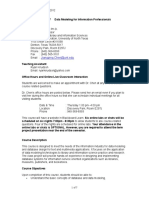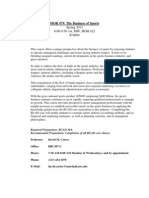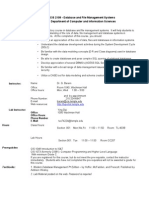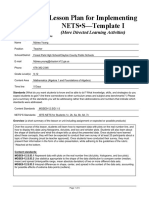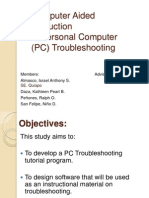IOM 435 - Business Database Systems
IOM 435 - Business Database Systems
Uploaded by
socalsurfyCopyright:
Available Formats
IOM 435 - Business Database Systems
IOM 435 - Business Database Systems
Uploaded by
socalsurfyOriginal Title
Copyright
Available Formats
Share this document
Did you find this document useful?
Is this content inappropriate?
Copyright:
Available Formats
IOM 435 - Business Database Systems
IOM 435 - Business Database Systems
Uploaded by
socalsurfyCopyright:
Available Formats
Marshall School of Business University of Southern California
IOM 435 Spring 2013
IOM 435 - Business Database Systems
Time: Place: Professor: Office hours: Phone: FAX: Email: Blackboard: Tuesdays & Thursdays 12:00 - 1:50 PM HOH 301 Douglas Shook, Ph.D. JHH 102 Tu/Th 3:30 - 4:30 PM, after class and by appointment office: 740-6818 office: 821-0264 shook@esd.usc.edu https://blackboard.usc.edu
Overview of the Course: Database approaches have become the foundation of most business information systems. Efforts to support Data Analytics (DA) and Business Intelligence (BI), Customer Relationship Management (CRM), increased reliance on ERP packages (e.g., SAP, PeopleSoft, Baan, etc.), exposing business data to customers through web-based customer interfaces, compliance with Sarbanes-Oxley/HIPAA/FERPA, recognition of the importance of Big Data, synchronizing/integrating legacy data with Cloud-based applications, etc., continue to accelerate the need to move toward more comprehensive data integration and enterprise-wide data management. This course is motivated by a recognition of the importance of databases for understanding, designing and building effective information systems for today's business organizations. The objective of this course is to provide the prospective business or information systems professional with fundamental concepts and skills in data modeling (conceptual, logical and physical), as well as in designing, building and managing the data layer to support business applications. In addition to data modeling, considerable proficiency with Structured Query Language (SQL) will be obtained. Although object-oriented, and other database approaches will be discussed, the course focuses primarily on the use of state-of-the-art relational and object-relational databases. Oracle will be used as the primary pedagogical software in class and for required assignments. Prerequisites: None Required Readings/Materials: Hoffer, J., Ramesh, V. & Topi, H. (2011). Modern Database Management, 10th Edition. Pearson-Prentice Hall: New Jersey Additional articles/handouts to be distributed in class. Data processing template (e.g., Staedtler 977/112 available at bookstore), or similar template. Optional, Supplemental Readings: Loney, K. (2009). Oracle 11g - The Complete Reference, Osborne Oracle Press (ISBN: 0071598758). Earp, R. and Bahui, S. (2003). Learning SQL: a step-by-step guide using Oracle. Addison Wesley: New York (ISBN 0-201-77363-5). On Reserve in Crocker Library (three hour checkout): Hoffer, J., Ramesh, V. & Topi, H. (2011). Modern Database Management, 10th Edition. Pearson-Prentice Hall: New Jersey Hoffer, J., Prescott, M. & Topi, H. (2009). Modern Database Management, 9th Edition. Pearson-Prentice Hall: New Jersey (2 copies) Loney, K. (2004). Oracle 10g - The Complete Reference, Osborne Oracle Press (ISBN: 0072253517). Earp, R. and Bahui, S. (2003). Learning SQL: a step-by-step guide using Oracle. Addison Wesley: New York.
Marshall School of Business University of Southern California
IOM 435 Spring 2013
Course Details
Grading: Class Participation, In-Class Problem Solutions Oracle/SQL Programming Assignments Term Project In-Class Workshops (First @10%, Second and Third @15% each)
10% 20% 30% 40%
(Extraordinary work in any of the above components will be rewarded accordingly with "grade overflow" into the other components. As per the 20122013 grading guidelines established by the Marshall School of Business, the average grade in this course will be 3.3.)
Class Participation: Class participation be based upon class attendance, involvement in class discussions and responses to questions asked in class. Additionally, problems from the Hoffer text labeled "Problems and Exercises" will be assigned. Class participants will be chosen randomly to present their solutions on the board for class analysis and discussion. (individual work) Oracle/SQL Problems: Two hands-on programming assignments will be done using Oracle. You will turn in the computer generated output from your work. (individual work) Workshops: There will be three in-class workshops where you will perform data modeling (conceptual, logical, physical), as well as some SQL (DDL, DML, etc.). There will be no exams in this class. (individual work) Project: The term project will be the "cap stone" of the semester and requires the design of a database application and the implementation of this design using a database management system. The project will apply most of the issues/concepts covered during the semester and will enable you to obtain first-hand experience in designing and implementing a basic DBMS application from start to finish at an actual organizational site. It will be your responsibility to find a suitable project. In the past, students have done projects in the organization where they worked, for some department in the university, local retailers, businesses they frequent, churches, social organizations, governmental agencies, or for their friends' or relatives' businesses. I would encourage you to develop an application for a not-for-profit, or similar organization, which may be able to afford to undertake such a project for a fee. The term project will result in a coded application, a high quality written report and an oral presentation. The project will be undertaken in the small teams (generally between two and four members) with a minimum of three to five entities per member. Additional details regarding project requirements will be provided later. (group work) Class Administrivia: Unfortunately, a certain amount of administrivia, or housekeeping, is required for any course. Although I dislike including this section in the syllabus, it is only fair to make the course expectations clearly known at the outset of the class (hopefully there will be no surprises down the road). Following are the "rules" and expectations of the class: It is expected you will attend all class meetings. If you must miss a class, please inform me beforehand. There will be no "make-ups" for any work missed due to un-excused absences (this includes workshops). You will be expected to have prepared for each class by reading the assigned chapters and handouts. If you do not keep up with the readings, you will neither enjoy, nor benefit from the class. Typically I will use a randomized class list to call upon students to present their solutions to the assigned Problems and Exercises at the end of each chapter.
Marshall School of Business University of Southern California
IOM 435 Spring 2013
General Comments
The content of this course is by nature somewhat narrow focused and somewhat technical. It is designed to provide the participant with a reasonably thorough understanding of database design and implementation in business organizations. It also provides the participant with first-hand exposure to the entire database design and implementation process in an actual organization. Mastery of business data modeling, and data layer-related concepts, increasingly are becoming essential skills for any individual pursuing a career in Information Systems. This class will provide a foundation for professional development. It is assumed that the participants in this course wish to achieve some level of mastery over the database process. The course assumes some previous knowledge of, and exposure to, information systems. This course is not intended to be a general survey course on information technologies (see IOM 431), nor is it an explicit course in systems analysis and design (see IOM 433).
Academic Integrity
The use of unauthorized material, communication with fellow students during an examination, attempting to benefit from the work of another student, and similar behavior that defeats the intent of an examination or other class work is unacceptable to the University. It is often difficult to distinguish between a culpable act and inadvertent behavior resulting from the nervous tensions accompanying examinations. Where a clear violation has occurred, however, the instructor may disqualify the student's work as unacceptable and assign a failing mark on the paper . Violations of academic integrity will not be tolerated in this course. Violations of academic integrity include, but are not limited to: 1. Plagiarism - the submission of any material authored by another person, whether or not the original author gave permission to use the material. 2. For individual assignments - any inappropriate collaboration or copying of solutions. Students are encouraged to discuss assignments, to work together, and to share knowledge, as long as the exchange of information is related to understanding the material, and not for the purpose of sharing actual solutions to the assignment. 3. For the workshops - any communication of information, or reference to any sources of information, other than with the professor or the TA. 4. Any effort to uncover, and/or use, any materials from previous semesters, or from other sections, or from other students of this course (this includes data modeling cases and programming assignments). 5. Any violation of the academic integrity standards set forth in the student conduct code. Students are expected to be familiar with these standards, as well as being familiar with the ramifications of violating these standards. In an effort to create a high integrity learning opportunity for all, and to ensure fairness in grading during the course of the semester, the professor and the teaching assistants will endeavor assiduously to uncover any violations of academic integrity. Depending upon the severity of the infraction, the professor will seek recourse up to, and including, expulsion from the university.
Students with Disabilities
Any student requesting academic accommodations based on a disability is required to register with Disability Services and Programs (DSP) each semester. A letter of verification for approved accommodations can be obtained from DSP. Please be sure the letter is delivered to me as early in the semester as possible. DSP is located in STU 301 and is open 8:30 a.m. - 5:00 p.m., Monday through Friday. The phone number for DSP is (213) 740-0776.
Classroom Recording
Various portions of this class may be captured/recorded for subsequent use by the students. The links to the recordings will be placed in Blackboard and only the students in this class should have access to them recorded. Please note that your voice and or image may be recorded in the process. 3
Marshall School of Business University of Southern California
IOM 435 Spring 2013
Course Schedule Version 1a (subject to change)
Date Topic Readings/Questions
Module 1 - Introduction to the Database Environment
Jan. 15 Jan. 17 Jan. 22 Jan. 24 Administrivia, Course Overview and Announcements The Database Environment I The Database Environment II & Team Composition Database Development Process none / none Chap. 1 pp. 1-24 / none (same as previous session) Chap. 1 pp. 24-43, handout/none
Module 2 - Conceptual Database Design
Jan. 29 Jan. 31 Feb. 5 Feb. 7 Conceptual Data Modeling/Entity Relationship Diagrams I Conceptual Data Modeling/Entity Relationship Diagrams II Conceptual Data Modeling/Entity Relationship Diagrams III Conceptual Data Modeling/Entity Relationship Diagrams IV Chap. 2 & Appendix A / 5, 8, 15a-d, 18 (same as previous session) (same as previous session) (same as previous session) Chap. 3 / 2, 7, 8, 12 (same as previous session) (same as previous session) none / none none / none
Feb. 12 Advanced Conceptual Modeling I Feb. 14 Advanced Conceptual Modeling II Feb. 19 Advanced Conceptual Modeling III Feb. 21 First Hands-on Workshop Feb. 26 First Workshop Solutions, Discussion & Analysis
Module 3 - Structured Query Language (SQL)
Feb. 28 Mar. 5 Mar. 7 Mar. 12 Introduction to Structured Query Language I Introduction to Structured Query Language II Advanced Structured Query Language I Advanced Structured Query Language II Chap. 6 & handout / 2-4, 7-10 (same as previous session) Chap. 7 & handout / 1-5 (same as previous session)
Module 4 - Logical Database Design
Mar. 14 Mar. 19 Mar. 21 Mar. 26 Mar. 28 Mar. 29 Mar. 30 Apr. 2 Logical Design and the Relational Model I Spring Break no class Spring Break no class Logical Design and the Relational Model II Second Hands-on Workshop Friday - Conference with professor on project status Chap. 4, Appendix B / 1A-2D, 3 None None (same as previous session) none / none
Bring EDM, Function vs. Entity, hard copy of user views, ERDs Saturday - Conference with professor on project status etc. Second Workshop Solutions, Discussion, Analysis none / none
Marshall School of Business University of Southern California
IOM 435 Spring 2013
Course Schedule
Date Topic Readings/Questions
Module 5 - Physical Database Design
Apr. 4 Apr. 9 Apr. 11 Apr. 16 Apr. 18 Apr. 23 Physical Design I Physical Design II Physical Design III Physical Database Optimization I Physical Database Optimization II Physical Design & PL/SQL Chap. 5, pp., Appendix C / 1-3, 5, 7, 8, 16 (same as previous session) (same as previous session) (same as previous session) (same as previous session) PL/SQL handout
Module 6 - The "Wrap"
Apr. 25 Apr. 30 May 2 May 15 Third Hands-on Workshop Third Workshop Solutions, Discussion, Analysis Project "Spot" Presentations Semester Projects Due @ JHH 102 from 2:00-4:00 none / none none / none none / none none / none
Marshall School of Business University of Southern California
IOM 435 Spring 2013
Components of the Database Design Project Report
A. Introduction 1. Cover page 2. Table of Contents 3. Executive Summary B. Planning for the Database Please see handout Practical Database Development for detailed instructions on Step B here (the textbook is not thorough on this step). 4. Business Function-to-Data Entity Matrix (page 24) 5. Preliminary Enterprise Data Model (EDM) (page 51, but we also will show minimum cardinality) C. Conceptual Design 6. Entity Relationship Diagrams (ERDs) for each user view. You also must attach the original "hard copy" of the user view for comparison - please make it clear which ERD is for which user view. Some annotation for each user view is expected. 7. Create a conceptual data model (CDM) by integrating all the individual user views into one ERD 8. Business Rules/Constraints a. Domain Definitions (create domain classes and refer individual attributes to them - page 162) b. Other business rules, restrictions, constraints and requirements for the database D. Logical Design with the Relational Model 9. Transform the conceptual data model into a set of Third Normal Form (3NF) relations indicating all primary and foreign keys, making note of any changes from the CDM due to normalization. E. Physical Design and Implementation with the Relational Model 10. a. Functionally decompose/expand your Business Function-to-Data Entity Matrix into a Process versus Entity Matrix (see lecture handout) b. Two or three Transaction Analysis Forms (TAFs) of key processes (see lecture handout). 11. Composite Usage Map - combine TAFs with remaining usage and volume estimates (lecture & p.210) 12. List of all DDL statements necessary to create the physical model, making note of any changes from the logical model due to physical design/performance considerations. 13. List contents of all populated tables/relations to show sample data (if output wraps on the page, Please format it so it is readable). 14. List six sample queries/views and the results of their executions (show the query statements/code and the output they generated). This is a good opportunity to showcase your SQL skills. 15. Summary discussion of your physical design (e.g., index creations, clustering, responses to table volumes and access patterns, denormalizations, data distribution, table partitioning, triggers, stored procedures, security issues, physical implementation of the constraints, etc.). This portion of the report "implements" your project, please be rigorous/thorough here. F. Summary and Conclusion Discuss difficulties encountered, how you solved problems, what you like most/least about your database and what you learned (a thorough description will be appreciated here). Please note: You must submit files (i.e., a disk or USB drive) containing all SQL code and output for your database tables, views, queries, etc. The report must be page numbered; the entries in the table of contents should appear as headings in the appropriate report sections. It should be well written in a "normal form" for business reports. As always, the report must have sufficient annotation (text) to explain why each diagram or page is in the report and what it is telling the reader. If you have questions regarding report format, please see me as I have samples from previous semesters. Please start this project early as possible; it will take longer to complete than you think.
You might also like
- Data Structures and Algorithm Analysis in C++, Third EditionFrom EverandData Structures and Algorithm Analysis in C++, Third EditionRating: 4.5 out of 5 stars4.5/5 (7)
- 5707 Fall 2012 Syl Lab UsDocument7 pages5707 Fall 2012 Syl Lab UsManish PatelNo ratings yet
- BMED-3101 SyllabusDocument2 pagesBMED-3101 SyllabusCARMEN MOROTE GARCIANo ratings yet
- Data Structures and Algorithm Analysis in Java, Third EditionFrom EverandData Structures and Algorithm Analysis in Java, Third EditionRating: 4.5 out of 5 stars4.5/5 (6)
- The Art and Science of Decision MakingDocument13 pagesThe Art and Science of Decision MakingsocalsurfyNo ratings yet
- Mor 479Document13 pagesMor 479socalsurfyNo ratings yet
- MKT 445Document7 pagesMKT 445socalsurfyNo ratings yet
- Kyambogo University Private Admission List For The Academic Year 2015/2016. 2015-2016Document449 pagesKyambogo University Private Admission List For The Academic Year 2015/2016. 2015-2016The Campus TimesNo ratings yet
- DISC 112-Computers& Problem Solving-Zehra Waheed-Shakeel Sadiq JajjaDocument5 pagesDISC 112-Computers& Problem Solving-Zehra Waheed-Shakeel Sadiq JajjatuahasiddiquiNo ratings yet
- Data Management and Systems Modeling PDFDocument6 pagesData Management and Systems Modeling PDFLalitha MaridiNo ratings yet
- Faculty: Information Technology Department: Computer Information SystemsDocument3 pagesFaculty: Information Technology Department: Computer Information Systemsrajarajkumar543No ratings yet
- CIT 365 Syllabus FALL 2011Document11 pagesCIT 365 Syllabus FALL 2011Warda SalehNo ratings yet
- IME 550: Operations Research SyllabusDocument4 pagesIME 550: Operations Research SyllabusMuhammadZaydArattKhanNo ratings yet
- Foreign Studies Thesis Grading SystemDocument6 pagesForeign Studies Thesis Grading Systemmarilynmarieboston100% (2)
- CIS 2109 - Database and File Management Systems Department of Computer and Information SciencesDocument5 pagesCIS 2109 - Database and File Management Systems Department of Computer and Information SciencesPadma NayakNo ratings yet
- Online Grading System Thesis SampleDocument6 pagesOnline Grading System Thesis Samplefjcz1j5g100% (2)
- DBMS SyllabusDocument4 pagesDBMS SyllabusRishabh PatelNo ratings yet
- Managing Files FoldersDocument2 pagesManaging Files FoldersAbrar GirkarNo ratings yet
- Quantitative Methods in Business, Bus 1B Course Syllabus: Updated: 12/5/2013Document6 pagesQuantitative Methods in Business, Bus 1B Course Syllabus: Updated: 12/5/2013william1230No ratings yet
- Syllabus Spring 2016 CIS 4296Document6 pagesSyllabus Spring 2016 CIS 4296troll4500No ratings yet
- Lesson Plan ProjectDocument6 pagesLesson Plan Projectapi-608836622100% (1)
- DISC 112-Computers and Problem Solving-Muhammad Naiman Jalil-Zehra WaheedDocument4 pagesDISC 112-Computers and Problem Solving-Muhammad Naiman Jalil-Zehra Waheed16110299No ratings yet
- Course InfoDocument3 pagesCourse Infoletscode.128No ratings yet
- Thesis School Management SystemDocument8 pagesThesis School Management Systemgjhr3grk100% (1)
- Coursework ReportDocument5 pagesCoursework Reportf5dct2q8100% (2)
- Project Management A Systems Approach ToDocument7 pagesProject Management A Systems Approach ToAlan LuNo ratings yet
- Dissertation PagesDocument6 pagesDissertation PagesCustomPaperServicesCanada100% (1)
- Online Scheduling System Thesis DocumentationDocument7 pagesOnline Scheduling System Thesis Documentationsarahgriffinbatonrouge67% (3)
- If Programming Were A Term PaperDocument4 pagesIf Programming Were A Term Paperafmzinuvouzeny100% (1)
- ADMS 3370 Winter2021 - Course OutlineDocument6 pagesADMS 3370 Winter2021 - Course OutlineFinchley SangNo ratings yet
- Writing A Thesis Chapter 1Document8 pagesWriting A Thesis Chapter 1staceywilsonbaltimoreNo ratings yet
- COSC 2336, 01W, Data Structures and Algorithms: Instructor InformationDocument8 pagesCOSC 2336, 01W, Data Structures and Algorithms: Instructor InformationTetteh SamuelNo ratings yet
- Itec 7430 Syllabus Fall2017 1Document9 pagesItec 7430 Syllabus Fall2017 1api-381991708No ratings yet
- UT Dallas Syllabus For Eco4348.001 05f Taught by Donald Hicks (Dahicks)Document7 pagesUT Dallas Syllabus For Eco4348.001 05f Taught by Donald Hicks (Dahicks)UT Dallas Provost's Technology GroupNo ratings yet
- DB - Week 1Document22 pagesDB - Week 1Syed IrtazaNo ratings yet
- MSC Computer Science Dissertation StructureDocument5 pagesMSC Computer Science Dissertation StructureWebsitesThatWritePapersForYouNewark100% (1)
- PHP2517 Spring2024Document8 pagesPHP2517 Spring202405minis.shearsNo ratings yet
- 17.804: Quantitative Research Methods IIIDocument9 pages17.804: Quantitative Research Methods IIIHéctor FloresNo ratings yet
- Cs4604 SyllabusDocument4 pagesCs4604 SyllabusTota BinothmanNo ratings yet
- BUS3020 Syllabus A15 Rev001Document6 pagesBUS3020 Syllabus A15 Rev001KyleHudginsNo ratings yet
- Computer Aided InstructionDocument22 pagesComputer Aided InstructionIsrael Anthony AlmascoNo ratings yet
- Machine LearningDocument3 pagesMachine LearningSanjay KumarNo ratings yet
- Example Thesis Database SystemDocument8 pagesExample Thesis Database Systemamandahengelfargo100% (2)
- MGT 472.002 - Management Information Systems Course Syllabus - Fall 2017Document5 pagesMGT 472.002 - Management Information Systems Course Syllabus - Fall 2017Ken MatoNo ratings yet
- Sample Thesis For Computer Science StudentsDocument7 pagesSample Thesis For Computer Science Studentsfygynejoheg2100% (1)
- Computer Science Thesis Proposal PhilippinesDocument6 pagesComputer Science Thesis Proposal Philippinesyvrpugvcf100% (2)
- Syllabus RegressionDocument2 pagesSyllabus RegressionShashank BhaskerNo ratings yet
- ORIE4820 SyllabusDocument6 pagesORIE4820 SyllabusBrittany PuzarNo ratings yet
- Thesis Educational ManagementDocument5 pagesThesis Educational Managementnicolledammannfargo100% (3)
- Syllabus 12Document18 pagesSyllabus 12api-376208509No ratings yet
- Thesis Classroom ManagementDocument6 pagesThesis Classroom Managementmarystevensonbaltimore100% (3)
- Thesis About Online Viewing of GradesDocument4 pagesThesis About Online Viewing of Gradesbsrf4d9d100% (2)
- BUAD 425 SyllabusDocument7 pagesBUAD 425 SyllabussocalsurfyNo ratings yet
- DBMSDocument13 pagesDBMStigerNo ratings yet
- SyllabusDoc S17 335Document7 pagesSyllabusDoc S17 335hicu0No ratings yet
- UT Dallas Syllabus For Ba3351.006.11f Taught by Eugene Deluke (gxd052000)Document8 pagesUT Dallas Syllabus For Ba3351.006.11f Taught by Eugene Deluke (gxd052000)UT Dallas Provost's Technology GroupNo ratings yet
- Thesis Chapter 7Document4 pagesThesis Chapter 7kimberlyhighyonkers100% (2)
- Syllabus: Database System Design, Management and Administration - Msis 4013Document4 pagesSyllabus: Database System Design, Management and Administration - Msis 4013Nguyễn Khánh HàNo ratings yet
- ESI 4312 - Operations Research 1 Syllabus: Jean-Philippe P. Richard Spring 2014Document9 pagesESI 4312 - Operations Research 1 Syllabus: Jean-Philippe P. Richard Spring 2014Sieggy Bennicoff YundtNo ratings yet
- CS4037 Syllabus S1 24-25Document9 pagesCS4037 Syllabus S1 24-25Jamie LeeNo ratings yet
- Conceptual Framework Thesis IpoDocument5 pagesConceptual Framework Thesis Ipogbvhhgpj100% (2)
- System Analysis and DesignDocument8 pagesSystem Analysis and Designobrie diazNo ratings yet
- Manarat International University: Course Outline: Management Information Systems & Decision Making Techniques (MIS-531)Document8 pagesManarat International University: Course Outline: Management Information Systems & Decision Making Techniques (MIS-531)Md. Abdullah Al MahmudNo ratings yet
- ITM Module 3 DEVELOPING AND IMPLEMENTING INFORMATION SYSTEMSDocument103 pagesITM Module 3 DEVELOPING AND IMPLEMENTING INFORMATION SYSTEMSmbalauelijahNo ratings yet
- Mor 571Document27 pagesMor 571socalsurfyNo ratings yet
- Mor 570Document13 pagesMor 570socalsurfyNo ratings yet
- Mor 569Document1 pageMor 569socalsurfyNo ratings yet
- Mor 566Document24 pagesMor 566socalsurfyNo ratings yet
- Mor 569Document13 pagesMor 569socalsurfyNo ratings yet
- Mor 555Document22 pagesMor 555socalsurfyNo ratings yet
- Mor 567Document12 pagesMor 567socalsurfyNo ratings yet
- Mor 560Document13 pagesMor 560socalsurfyNo ratings yet
- Mor 551Document13 pagesMor 551socalsurfyNo ratings yet
- MOR 499 SustainabilityDocument25 pagesMOR 499 SustainabilitysocalsurfyNo ratings yet
- Mor 472Document12 pagesMor 472socalsurfyNo ratings yet
- Mor 463Document8 pagesMor 463socalsurfyNo ratings yet
- Mor 548Document12 pagesMor 548socalsurfyNo ratings yet
- MKT 430Document23 pagesMKT 430socalsurfyNo ratings yet
- Iom 581 TTH Syllabus: Sosic@Marshall - Usc.EduDocument11 pagesIom 581 TTH Syllabus: Sosic@Marshall - Usc.Edusocalsurfy0% (1)
- Overview of MKT 543: Market Demand and Sales Forecasting Instructor: Professor S. Siddarth Reasons To Take This CourseDocument1 pageOverview of MKT 543: Market Demand and Sales Forecasting Instructor: Professor S. Siddarth Reasons To Take This CoursesocalsurfyNo ratings yet
- Sample Syllabus For Deals Course - This Was The 2011 SyllabusDocument7 pagesSample Syllabus For Deals Course - This Was The 2011 SyllabussocalsurfyNo ratings yet
- MKT 512Document12 pagesMKT 512socalsurfyNo ratings yet
- MKT 556Document5 pagesMKT 556socalsurfyNo ratings yet
- MKT 499 EthicsDocument9 pagesMKT 499 EthicssocalsurfyNo ratings yet
- For FBE 571, 572, or 573 For Spring 2013: Request To Register and Prerequisite WaiverDocument6 pagesFor FBE 571, 572, or 573 For Spring 2013: Request To Register and Prerequisite WaiversocalsurfyNo ratings yet
- Business Models For Interactive Digital Media & Services: Gsba 556 - O A. E SDocument6 pagesBusiness Models For Interactive Digital Media & Services: Gsba 556 - O A. E SsocalsurfyNo ratings yet
- Iom 431Document10 pagesIom 431socalsurfyNo ratings yet
- Gsba 520Document42 pagesGsba 520socalsurfyNo ratings yet
- Digital Strategies For Sustainability in Global Emerging MarketsDocument7 pagesDigital Strategies For Sustainability in Global Emerging MarketssocalsurfyNo ratings yet
- CEO P, C G, P F: University of Southern CaliforniaDocument11 pagesCEO P, C G, P F: University of Southern CaliforniasocalsurfyNo ratings yet
- Fbe 560Document7 pagesFbe 560socalsurfyNo ratings yet
- Challenges of Studying Part-Time While Working Towards Employee's Job Performance.24pgsDocument24 pagesChallenges of Studying Part-Time While Working Towards Employee's Job Performance.24pgsMohd HisammudinNo ratings yet
- Student ProfileDocument1 pageStudent ProfileAngelyn Cayao MagbanuaNo ratings yet
- TIMEthis PDFDocument5 pagesTIMEthis PDFAuror RonNo ratings yet
- Email ID and Telephone Numbers of Officials Dealing With Student GrievancesDocument2 pagesEmail ID and Telephone Numbers of Officials Dealing With Student GrievancesDilkash DhillonNo ratings yet
- 3,000 Most Frequent Core Academic WordsDocument197 pages3,000 Most Frequent Core Academic WordsAnonymous D2w2TT100% (1)
- College Search Graphic OrganizerDocument6 pagesCollege Search Graphic Organizerapi-277277193No ratings yet
- 02 Introduction - Lecture PDFDocument54 pages02 Introduction - Lecture PDFNabeela NadeemNo ratings yet
- RESUMEDocument2 pagesRESUMEelumalaiNo ratings yet
- Education Board BangladeshDocument1 pageEducation Board BangladeshMd Nahidul AlamNo ratings yet
- Government Junior High School Profile, Sy 2020-2021Document51 pagesGovernment Junior High School Profile, Sy 2020-2021jovenel magnoNo ratings yet
- Fulbright EssaysDocument5 pagesFulbright EssaysCristina SilalahiNo ratings yet
- आईआरईएल (इंडिया) लललिटेि IREL (India) Limited: (Formerly Indian Rare Earths Limited)Document8 pagesआईआरईएल (इंडिया) लललिटेि IREL (India) Limited: (Formerly Indian Rare Earths Limited)Jahnavi ChinnuNo ratings yet
- De Cuong On Tap Hoc Ki 1 Anh 9 CT MoiDocument13 pagesDe Cuong On Tap Hoc Ki 1 Anh 9 CT MoiQuang Lê HiệpNo ratings yet
- M KrauszDocument14 pagesM KrauszHoang Phong TuanNo ratings yet
- Areyouquitter CLR DsDocument8 pagesAreyouquitter CLR DsmhqkxdkgfhNo ratings yet
- Pavni 1st SemDocument2 pagesPavni 1st Semarunarun99863No ratings yet
- Chris Bush ResumeDocument2 pagesChris Bush ResumeChris BushNo ratings yet
- Plantilla de Excel para Notas AcademicasDocument6 pagesPlantilla de Excel para Notas Academicasdopper_xtNo ratings yet
- Rubricfor Poster MakingDocument1 pageRubricfor Poster MakingAndrey Joseph BayangNo ratings yet
- Training ManualDocument15 pagesTraining ManualTariq AhmedNo ratings yet
- DLP in Arithmetic Sequence For DEMODocument9 pagesDLP in Arithmetic Sequence For DEMOAliyah Monique Benitez100% (1)
- Montgomery County Guide Recreation and Park Programs: Winter 2011-2012Document144 pagesMontgomery County Guide Recreation and Park Programs: Winter 2011-2012Planning DocsNo ratings yet
- Dr. Nawar Khan - Quality Practices in EduDocument13 pagesDr. Nawar Khan - Quality Practices in EduNadeem AnsariNo ratings yet
- An Analysis On The Implementation of TheDocument11 pagesAn Analysis On The Implementation of TheMaryJoylene De Arca Itang100% (1)
- ML Lab ManualDocument40 pagesML Lab ManualvarshaNo ratings yet
- Maths Plus - A Book of Mental Mathematics For Class-1Document57 pagesMaths Plus - A Book of Mental Mathematics For Class-1ZULFIKAR DABIR100% (1)
- Wiley Jackson, Accounting MajorDocument2 pagesWiley Jackson, Accounting Majorreza purnama eka putriNo ratings yet
- Test Report Form: Candidate DetailsDocument1 pageTest Report Form: Candidate DetailsdhawanendddNo ratings yet
- Civil Law E-PrimerDocument11 pagesCivil Law E-PrimercmontefalconNo ratings yet

